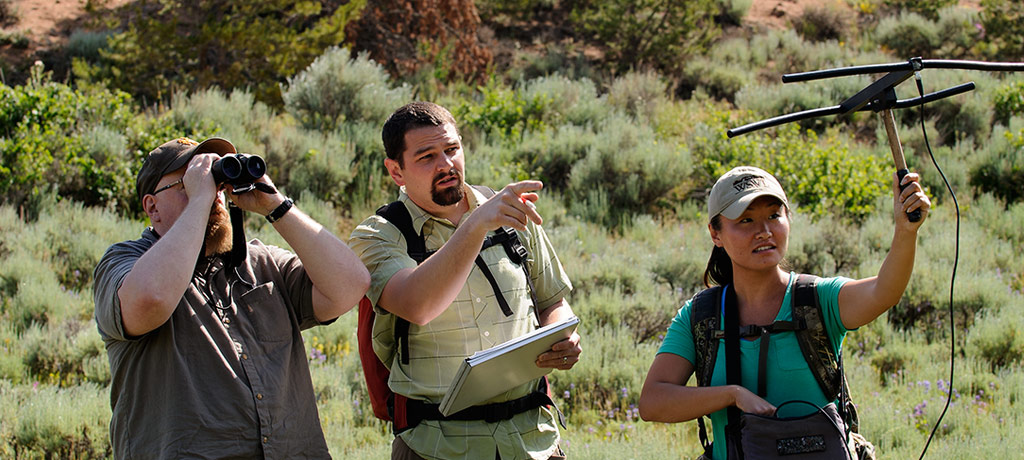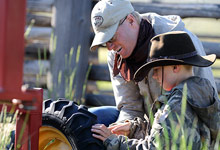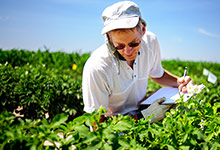
Main Content
Seeking Solutions
Scientists work to answer vital questions leading to wildlife and livestock health and management
Volume 15 | Number 1 | September 2013
By Steve Miller
Share This Story:
Turns out there really are discouraging words where the deer and antelope play, but faculty members and graduate students in the University of Wyoming’s Department of Veterinary Sciences are tackling these challenges.
Brucellosis, entrenched in the greater Yellowstone area, has an ever-present hammer poised. Chronic wasting disease (CWD) kills all its victims—no one knows how its machinery fools proteins in the animal brain, and there is no cure on the horizon. The 2006 bluetongue virus (BTV) outbreak in the Big Horn Basin sickened 35 percent of the sheep in flocks and killed 35 percent of those. Bluetongue runs in four- to seven-year cycles. This year may be ground zero.
While there are no silver bullets to any of these diseases, scientists in the department are making progress in answering vital questions that could lead to management solutions. Data point by data point, research study by research study, researchers are laying the foundations for future scientists and studies.
The Yellowstone area is the last natural reservoir of brucellosis in the U.S. Free-ranging bison and elk are the carriers, but elk are predominant. The disease causes females to abort their first calves following infection. Cattle can contract the disease, and the most common cause of transmission is thought to be oral. The Brucella bacteria can survive in the environment for more than 180 days in cool and moist conditions.
“For the layperson, it’s a very technically difficult problem that requires research to solve so you can make better wildlife management decisions and better domestic animal decisions and ultimately to help the state maintain its brucellosis free status,” says Jeff Adamovicz, a microbiologist/immunologist in the department.
The greater Yellowstone area supports about 450,000 cattle and calves. The cattle have the potential to interact with about 30,000 to 40,000 elk, according to Brant Schumaker, epidemiologist in veterinary sciences.
When brucellosis is found, the herd is quarantined for a year of testing or destroyed. A study by Schumaker, agricultural economist Dannele Peck and veterinary sciences master’s student Mandy Kauffman suggested a producer with a 400-head herd quarantined for one to six months during the winter feeding season because it interacted with an infected herd could incur $2,000 to $8,000 in uncompensated costs. A producer whose herd contracts brucellosis could incur $35,000 to $200,000 in uncompensated costs, depending upon whether the herd is destroyed and if the producer receives compensation, their study found.
Adamovicz seeks development of a vaccine for elk and also looks at current vaccination procedures for cattle. Ph.D. student Amanda Dougherty is studying elk response to infection, and master’s student Alex Kesterson is studying whether multiple vaccinations are a waste of resources for producers and perhaps harmful to their livestock.
“If we can reduce disease transmission and incidences, that’s a noble goal and certainly something that has economic impacts for ranchers, for food safety and the USDA,” says Adamovicz.
“They are interested in eradication even though we don’t think that is necessarily achievable. If we take steps in that direction by coming up with scientifically based recommendations for changing the vaccine approach in domestic animals, like cattle, we’ve done a pretty good service for the state and region.”
Cows aren’t elk, but what’s different in the elk’s immune system? “I’m currently using techniques to assess the immune function in elk in response to brucellosis,” says Dougherty. “The immune system is poorly understood, and one of the goals of the governor’s task force was to look at the immune function in elk.”
Former Gov. Dave Freudenthal created the Brucellosis Coordination Team in 2004 to chart a course for brucellosis management. Frank Galey, dean of the College of Agriculture and Natural Resources, chairs the group.
Elk have a different response to the disease, but no one understands why. Dougherty is also identifying genes of Brucella important during infection in elk.
Seeking CWD answers
Chronic wasting disease or CWD, meanwhile, is a death sentence. Its ramifications extend beyond whitetailed deer, mule deer, moose and elk and into economics. A 2006 study by the National Survey of Fishing, Hunting and Wildlife Associated Recreation shows 762,000 people participated in wildlife-associated recreation in Wyoming and pumped about $1.1 billion into Wyoming’s economy. The survey found 84 percent participated in some form of wildlife watching and 13 percent in hunting.
“If you want deer populations, you should be concerned,” says Todd Cornish, associate professor of pathology and director of the Wildlife-Livestock Health Center.
Cornish’s eyes give a no-nonsense look peering from underneath his ever-present baseball cap.
“Before you can decide if the disease is important or not, you need to know what it is doing to populations. And then before you can decide if you need to do anything about the disease, if there are any management actions you need to take or could be taken, you need to know what you are managing,” Cornish says.
“Otherwise, it’s the blind leading the blind, and nobody really knows what the cause and effect is or what the management actions will be or if they will be effective.”
Abnormal proteins called prions cause CWD. They are not viruses or bacteria, contain no nucleic acid and are not living organisms. The prions convert normal cellular protein in brain cells into the altered prion protein. As more cells die, the disease progresses, ultimately ending in death.
Cornish oversees CWD studies in white-tailed deer by Ph.D. student Dave Edmunds and a mule deer study by Ph.D. student Melia DeVivo in an area covering roughly the northern end of the Laramie Range into Converse County and a patch of Natrona County. They’ve trailed, collared, observed and taken blood samples from animals for more than eight years.
Edmunds was able to tell the Wyoming Game and Fish Department based on his data that the disease can cause population declines in whitetailed deer.
“And can conceivably cause population extinction,” adds Cornish.
With data fed into computer models, they found a possible solution.
“When female hunting was removed from our model, the population was sustainable,” says Edmunds. “We recommend, but that’s something we don’t control. That’s for the wildlife managers, the public and policymakers to decide.”
Says Cornish ominously, “Melia’s study is almost concluded and potentially tells us a darker and more disturbing story with regard to mule deer.”
Survival is not sustainable at this point for the population, DeVivo says. But there appears to be a less susceptible genotype linked to CWD.
“What is interesting is that there was a study done several years ago where they genotyped deer for the same area, and this less-susceptible genotype was very rare,” she notes.
Those deer are increasing in numbers in the study population.
“There may be some selection for this one genotype,” says Cornish, “but they can still get CWD but live longer—the disease is slower to kill them. By slower, we mean months or years slower. There may be some selection for those deer, and that may be a silver lining for long-term sustainability of this and other mule deer populations.”
Epidemiologist Schumaker is blessed with multifaceted talents. He applies his epidemiology expertise across diseases and species: He’s involved in CWD research and brucellosis and is applying his skills to Elaeophora, an arterial worm of white-tailed deer that also affects elk, moose and domestic sheep. Any particular day might find Schumaker collecting field data, analyzing that data in the lab, running computer simulation modeling of theoretical populations and how diseases may move through those populations and a risk assessment, or looking for potential for a disease to spring from one species to another.
He will come out from behind the science and address the science and address the wildlife-livestock landscape.
“A lot of our well-being in this state is directly tied to healthy livestock production,” Schumaker says. Let’s take it one step further. The One Health concept applies to human health as well. Knowing we have a secure food supply, knowing we have diseases that cross species boundaries into humans, we need to be active in evaluating animal diseases.”
Hot-button political diseases like brucellosis are challenging, he says.
“I think we’ve beaten brucellosis to death with regard to challenges associated with it,” he says. “Any disease that crosses species boundaries is a challenge because so many stakeholders are involved. As epidemiologists, we are trained to walk the line between stakeholder groups and try and find some commonsense solutions that will meet the needs of the general population and hopefully bridge the gap between stakeholder groups.”
Viral threat for sheep
Bluetongue virus is distributed worldwide and is emerging in areas not seen before, such as northern Europe, says veterinary virologist Myrna Miller.
The disease, spread by a biting midge, has vexed Wyoming wool producers for years. There are no vaccines licensed for use in Wyoming, and there are no effective vector controls, she says. Eartags containing pesticide are effective for four to six weeks, and a topical spray is available, but both can be impractical if producers have large herds. The first hard frost usually kills the midges.
Animals that survive develop antibodies, which tamps down the disease in a herd.
“After an utbreak, that herd immunity gradually wanes as the older animals die out,” says Miller. “There are weather factors as well. Weather patterns are cyclic. You see higher risk years having longer, hotter summers.”
With the cycle, so goes the disease emphasis. “Sheep aren’t the big players in Wyoming—cattle are. And sheep diseases don’t get a lot of attention,” says Miller. “But sheep really are part of the Wyoming culture and history. BTV can be devastating to these flocks. We’ll see it again—I can’t tell you when.”
Conventional wisdom says BTV is most active in northeast Wyoming and the Big Horn Basin, but there are no data to support that. Master’s student Kelsie Speiser collected 1,800 blood samples from white-tailed deer and pronghorn at hunter check stations in the falls of 2011 and 2012 and then tested them in the lab for BTV antibodies. She then mapped each result in Wyoming. Her model used elevation and average summer participation.
“It looks like there are definitely areas at higher risk that appear to be in the northeast angling down to Torrington, then additional risk in the Big Horn Basin,” she says. “There is additional risk in the Big Horn Basin, but not as high as the northeast side.”
Speiser is also studying the long-term antibody protection using modified live and killed virus vaccines. She tested 10 head of sheep with the modified live virus, 10 with the killed virus, and used 10 as a control. Speiser is drawing blood samples at intervals to determine antibody levels of the two vaccine types over time, and preliminary results are promising—ewes treated with both vaccines appear to be producing antibodies and passing those antibodies on to their lambs.
The Wyoming Livestock Board funded a large-scale project studying the effects of the vaccines. Speiser conducted a field trial of 300 head of sheep from around Wyoming. She just received samples and will finish testing them over the summer of 2013 and will report to the livestock board on the safety and preliminary efficacy of the vaccines by summer’s end.
















